Dell XPS 15 L521X: A Detailed First Look
by Jarred Walton on July 25, 2012 1:10 AM ESTDell XPS 15 Gaming Performance (with ThrottleStop)
This is where things get a bit messy and confusing. The CPU throttling on BIOS version A01 through A04 is a severe enough problem that out-of-box gaming performance on the XPS 15 is substantially lower than expected. In most games that we tested, CPU throttling kicks in after anywhere from 30 to 90 seconds, at which point the CPU sits at 1.2GHz until you exit the game. This makes benchmark results highly variable, with the first run always being the fastest, and frankly it’s unacceptable. How this slipped through the cracks on a shipping laptop is something of a mystery, as it took all of five minutes with DiRT 3 and Batman: Arkham City for me to determine something was wrong with performance, and to then track down the root cause. OEMs take note: both games have built-in benchmarks and your performance labs should be using these and other high-profile games to check performance before you start shipping product. End of discussion.
Now, with that out of the way, we wanted to see what the XPS 15 could do with a bit of fine tuning on CPU clocks. Under the default settings on the A04 BIOS, CPU temperatures topped out at 80C, which is lower than we’ve seen on quite a few laptops. Furthermore, CPU clocks were almost always 2.8GHz (maximum Turbo Boost for four threads or more on the i7-3612QM) before throttling down to 1.2GHz, which seems rather myopic. The whole point of Intel’s Turbo Boost is to let the CPU run at the maximum sustainable clock speed without overheating, and right now that’s not happening.
A bit of tinkering with ThrottleStop 5.0 Beta 3 yielded CPU temperatures in the 80-90C range with a 23X multiplier, with some games capable of running at 2.5 or even 2.6GHz without overheating. Again, this isn’t something an end user should be required to use in our opinion, but thankfully it does allow substantially improved performance and it’s easy enough to enable/disable as needed. Depending on the game in question, we saw performance improve by anywhere from 10% to over 100% by using a 23X multiplier with the CPU PROC HOT signal disabled—Batman and DiRT 3 showed the greatest improvements. Note also that the difference at higher quality settings isn’t as large, as the GPU becomes more of a bottleneck. We have 1080p “Enthusiast” results for the XPS 15 as well as our 768p “Value” and 900p “Mainstream” scores, but in most games 1080p Enthusiast wasn’t playable so we won’t report those scores for now. Let’s start with our Value and Mainstream results, and then we’ll list “recommended” settings and frame rates for the XPS 15 running at 1080p.
Value Gaming Performance
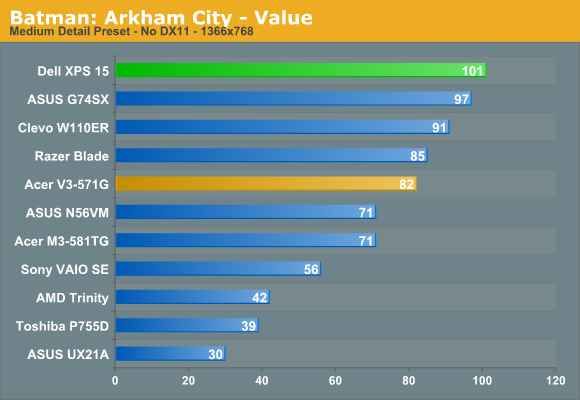


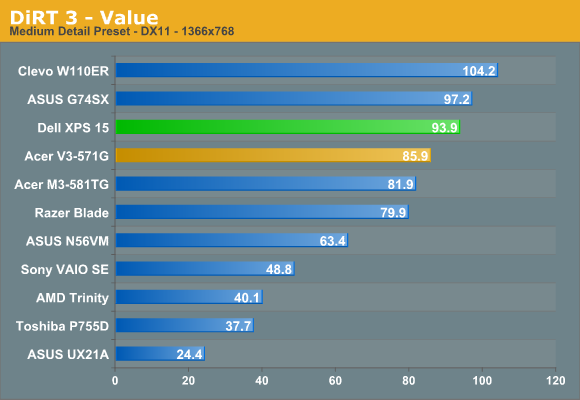
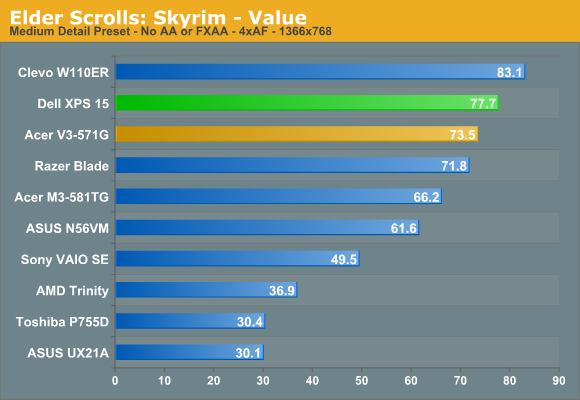
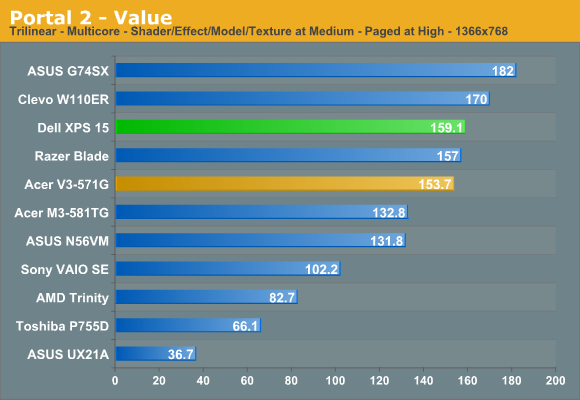
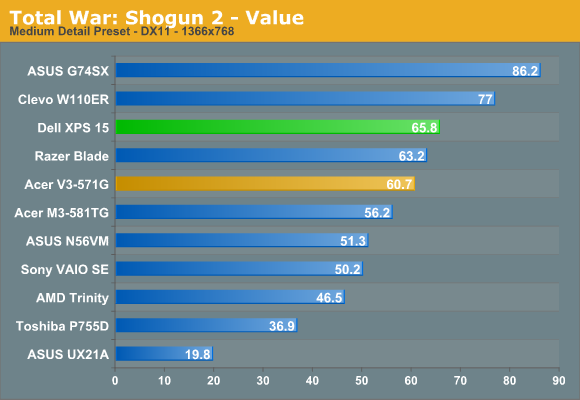
Our Value settings don’t pose any problem for the XPS 15, with all games easily besting 30FPS and most surpassing the 60FPS mark. The XPS 15 basically sweeps the table against the Acer V3, showing the value of using GDDR5 memory instead of DDR3 memory on the GPU. Also worth note is that Civilization V performance continues to be a bit quirky with certain driver versions; the original 296.01 drivers couldn’t even break 30FPS regardless of setting on the XPS 15, while the newer 304.79 beta drivers at least let you get 35FPS. One quick look at the W110ER results however shows that we ought to be able to get performance closer to 50FPS. I ran FRAPS while performing the Civ5 “lategameview” benchmark at one point to see what was going on, and for some reason performance appeared to fluctuate between 50FPS and 35FPS, where normally the frame rate is pretty steady. I’d guess a future NVIDIA driver will address the issue.
Mainstream Gaming Performance
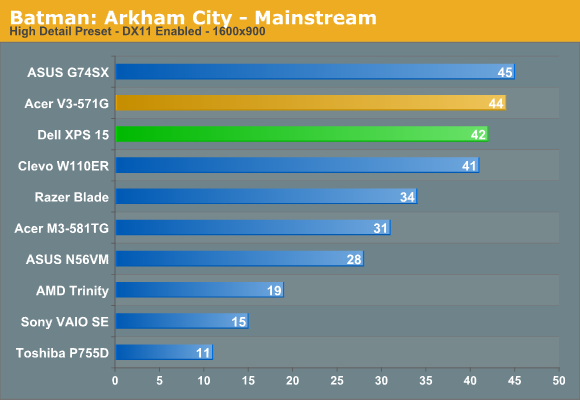

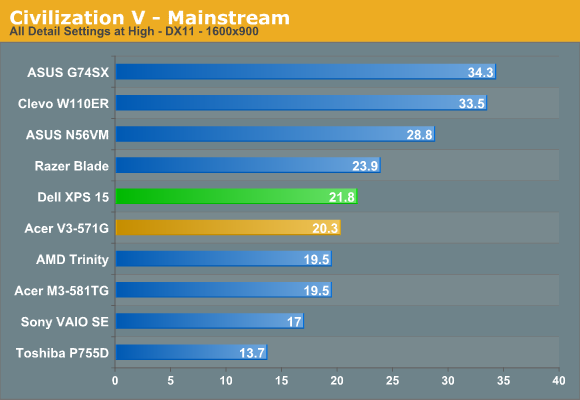
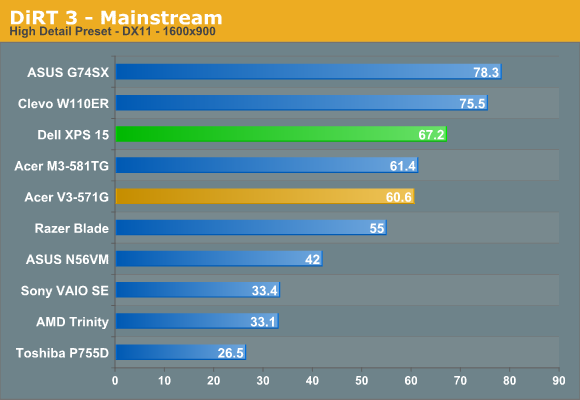
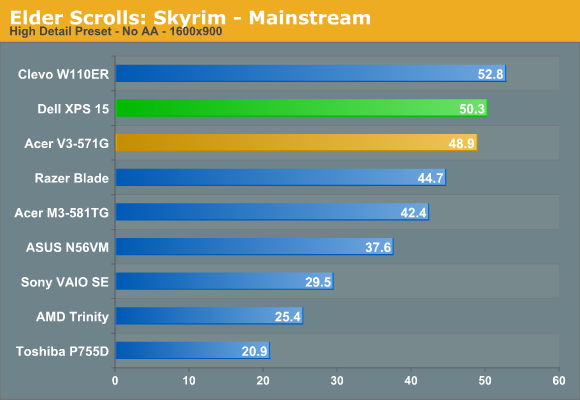
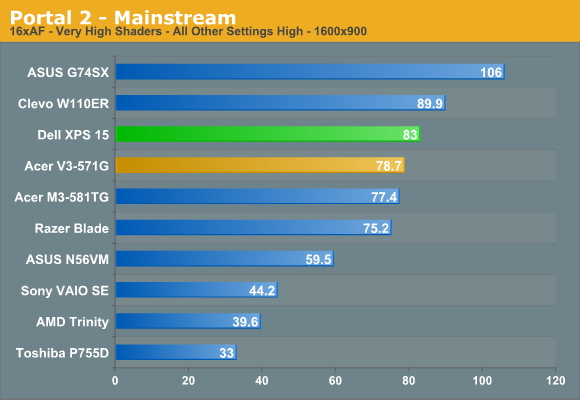
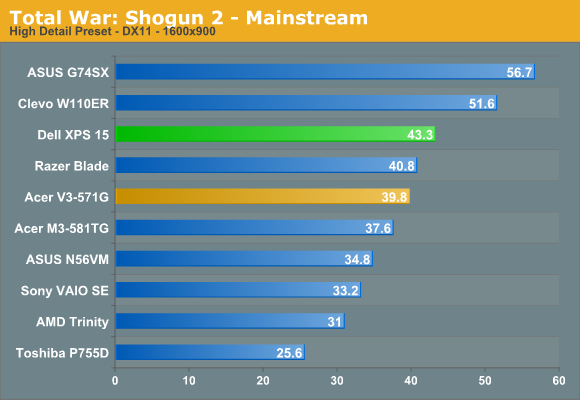
Mainstream performance generally follows the same pattern, only with lower frame rates. The GT 640M with GDDR5 is close to handling all of our test suite at 900p “High” details, with Battlefield 3 and Civilization V being the only two games where we’d recommend dropping to lower detail settings (and again, the drivers are likely a factor in Civ5 performance). It’s also interesting that the Acer V3 manages to eke out a win in Batman, indicating our lowered CPU clocks might be coming into play. Otherwise, the use of GDDR5 is typically able to improve GT 640M performance by an average of 8%, with up to 25% higher performance in at least one game (Batman using our Value settings).
|
Dell XPS 15 Gaming Recommended Settings for 1920x1080 |
|||
| Game | Detail | FPS | Notes |
| Batman: Arkham City |
Very High + 4xAA |
46 |
DX11 and PhysX both tend to be too much for the GT 640M, but you can max everything else out and maintain smooth frame rates. |
| Battlefield 3 |
Medium (“Value”) |
32.6 |
Single-player is okay at these settings, but multi-player will need to drop the resolution or use custom settings with some items on Low. |
| Civilization V | Low (“Value”) | 32.3 |
Civ5 needs a better driver, and we’ve seen higher scores in the past. Until then, setting everything to “Low” is your best bet for 1080p. |
| DiRT 3 | High + 4xAA | 45.8 |
Very fluid at the High defaults with 4xAA. If you try Ultra without AA, you’ll be closer to 30FPS. |
| Portal 2 | Max + 4xAA | 57.8 |
You can pretty much max out the settings in Portal 2 and still maintain fluid frame rates. |
| Skyrim | Ultra + 4xAA | 30.8 |
Skyrim is playable at 30FPS, and so our Enthusiast defaults work well enough. If you want slightly higher performance, you can use FXAA instead of 4xAA and get 35 FPS. |
| Total War: Shogun 2 |
High (“Mainstream”) |
34.8 |
The “High” preset seems to work best, though “Very High” with AA disabled is also viable. |
Most of the games’ settings are straightforward, but a couple warrant further explanation. In Batman, enabling Very High with PhysX is borderline playable, with an average frame rate of 27 FPS; DX11 without 4xAA is a similar 26 FPS, and enabling 4xAA in either mode drops a few FPS whereas FXAA is basically free. Civ5 performance is still a bit chaotic (see below), so take those scores with a grain of salt for now. Finally, our test scene in Skyrim happens to be one of the lowest performing areas we could find, so while we report 30 FPS there are many areas in the game that will run in excess of 60 FPS.
As mentioned earlier, Civilization V and Total War: Shogun 2 ran better with the most recent 304.79 beta drivers, and that’s what we used for the above settings. The remaining games all ran best with the official 296.01 Dell drivers, though at some point we expect to see a new WHQL driver that will provide the best of both worlds (and hopefully further improve Civ5 performance). Not shown in our charts is another popular game, Diablo III; given that the Acer V3 could handle maxed out settings, the same holds for the XPS 15. With GDDR5 memory, the GT 640M ends up being around 10% faster on average compared to DDR3; it can certainly handle gaming at 1080p, but in many games you’ll need to lower the detail settings somewhat to be fully playable.










109 Comments
View All Comments
solipsism - Wednesday, July 25, 2012 - link
1) How is the experience with that large trackpad. So far I haven't seen or experienced any notebook following Apple's path here that has made it a great experience.2) Regarding the first page, I think the quality of the display is also very important. the MBP might be a TN panel but it's a damn good TN panel. Asus also has plenty of great panels in what tend to be cheap machines. Since I'm always looking at the display I couldn't choose this Dell even if the PPI is decent.
Spivonious - Wednesday, July 25, 2012 - link
147dpi is "decent"? My, how times have changed. I remember when I bought my 125dpi CRT and it was top-of-the-line.Still, since most Windows apps aren't high-DPI aware, getting a high DPI screen on a laptop isn't as important as it is on a phone or tablet.
Don't get me wrong, I do like the higher DPI screens that we're seeing now, but calling 147dpi "decent" really made me laugh.
solipsism - Wednesday, July 25, 2012 - link
It's not a measure of percentage over a set time frame. It's simply a statement of what is deemed satisfactory.Note that at 141 PPI it's significantly more than the MBP at 110 PPI. Note that you only need to be 24" away from the display for it to be Retina quality for those with 20/20 vision.
PS: Even though we now have 200 PPI displays with the new MBPs don't think that ten years from now that display will be crap if it's not 5, 10 or 20x the pixel density. Around 200 PPI will be hear for a very long time.
Serge SC - Thursday, September 13, 2012 - link
I've had a 15.6" FHD screen for 3 years now.My eyes are in the 18/20 perhaps, even better, and still, I can't see the pixels while being around 50 cm away from my screen...
Sure, the more the merrier, but at full HD on this size of panel, it is good enough that 90% of users can't see pixels from normal usage distance.
SodaAnt - Wednesday, July 25, 2012 - link
Well, I've had a 1080P 15" laptop display for a while, and to be honest, as long as you are sitting in a normal position about two feet away from the screen, there is no way you can see the individual pixels. However, I do admit that they have a long way to go on making the screen look good though.Frallan - Wednesday, July 25, 2012 - link
Hmm had they been able to squeeze a 660 in there it would have been an immediate buy for me but the 640 just doesn't cut it. It would be interestin to see some new development in heat management in lappys - the same theory and build is still being used as for 10 yrs. I think that it should be possible today to think of a new way of doing things.xype - Wednesday, July 25, 2012 - link
Don’t worry, as soon as Apple decides to use any of the myriad of advanced cooling solutions, everyone will start doing it. It’s just, you know, too big a RISK to try it first. Better have another medicore model selling in small numbers than try and aim for Gold.ananduser - Wednesday, July 25, 2012 - link
What was said about this model regarding thermals is also true about Apple's MBP. As soon as you start pushing the hardware it too gets extremely hot.xype - Wednesday, July 25, 2012 - link
That’s why I said "as soon as Apple decides", meaning "they are not doing it, yet." Duh.Spoony - Wednesday, July 25, 2012 - link
In the past, I would have agreed with you wholeheartedly. Previous MacBook Pros (and PowerBooks) were absolute space heaters. They sat at about 95C as soon as you started doing anything intensive with them. Lap toasters!The fan ramps used by Apple are also hugely conservative in favour of noise, which I do not feel is the right trade off. Frequently you'd see 103C before the fans had ramped up all the way.
All this being said, I recently ran several stress tests to see if the differences Apple had made to the Retina MacBook Pro actually did anything. The results were extremely positive. A highly synthetic stress test on CPU/GPU yielded 82C highest temp (on the Nvidia card).
I bought a rMBP, and have been very satisfied with the thermal performance. Coming from somebody who was highly critical of all previous Apple machines in this regard. You do have to encourage the fan to ramp properly sometimes, so it isn't perfect. Just a lot better.